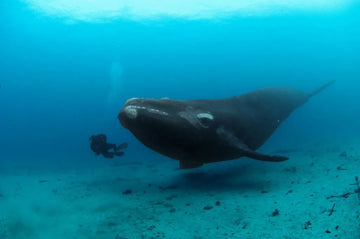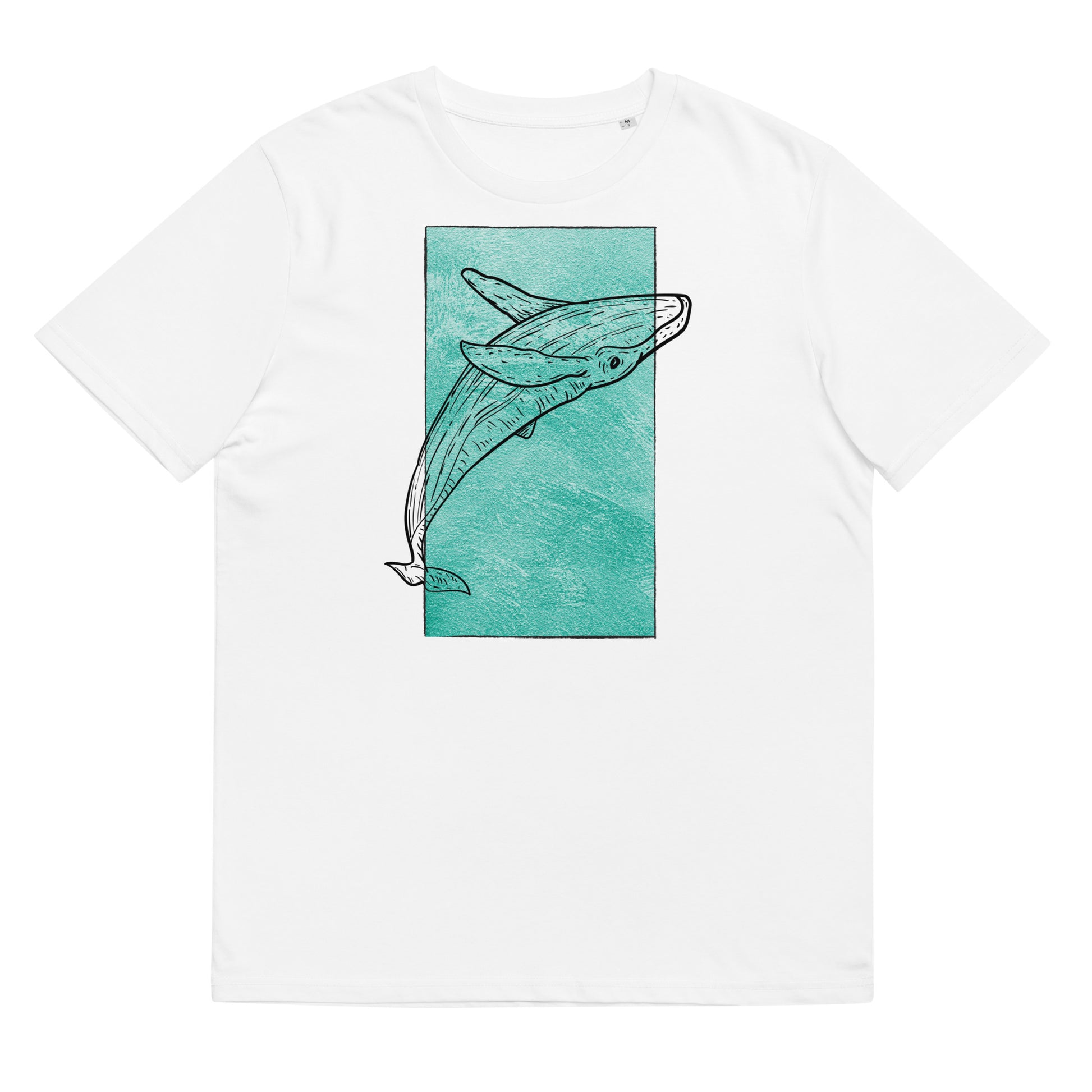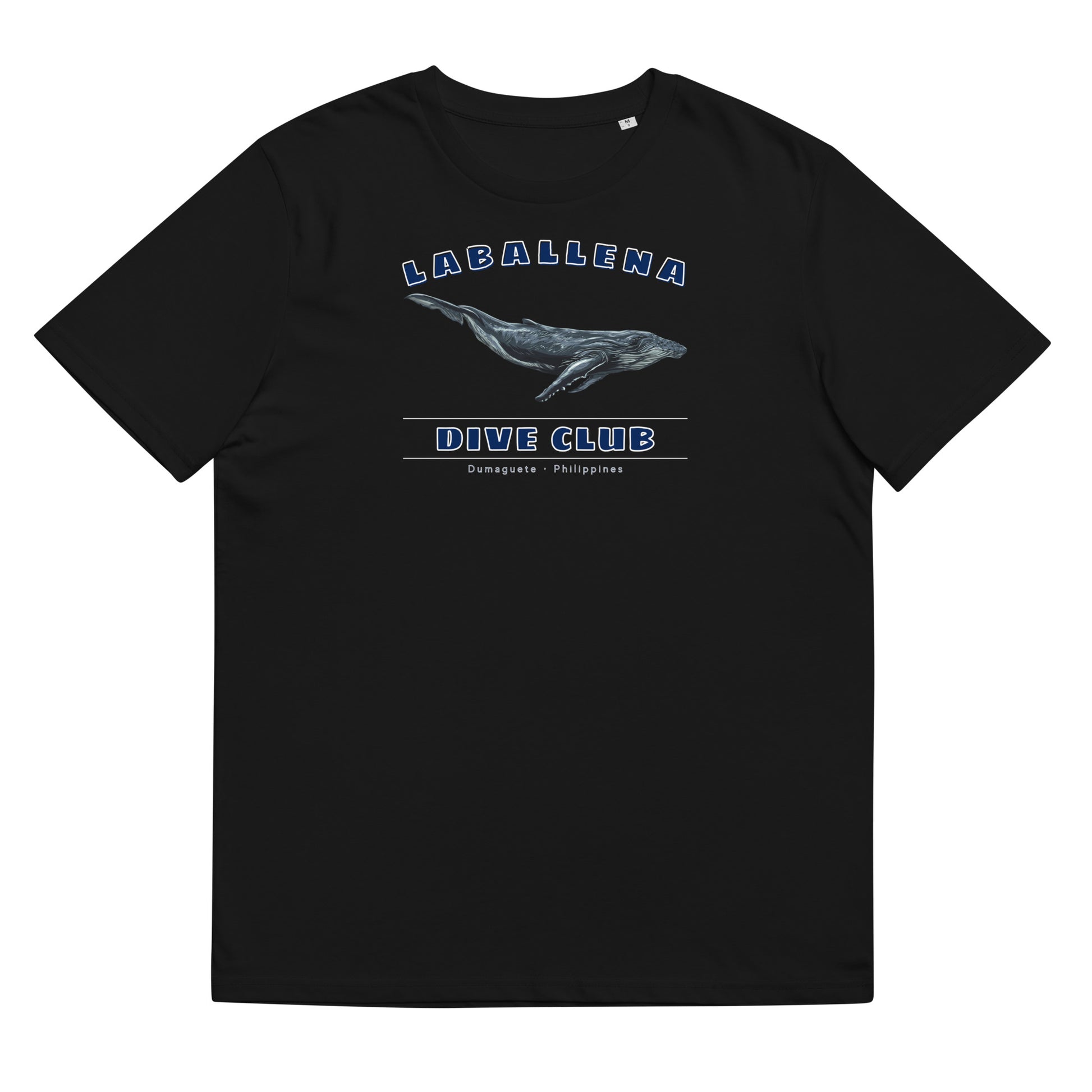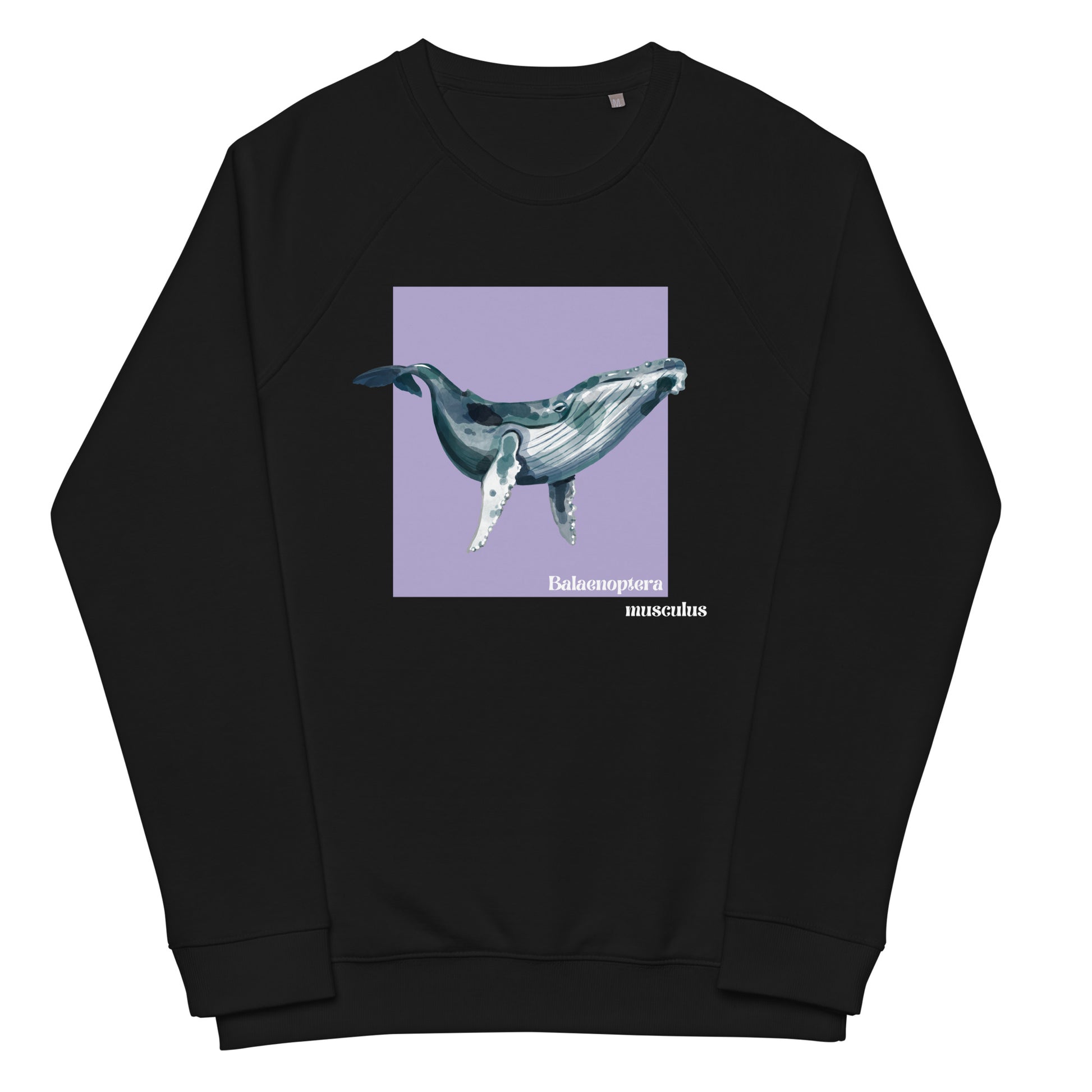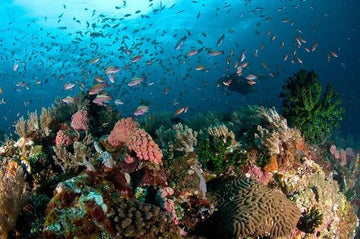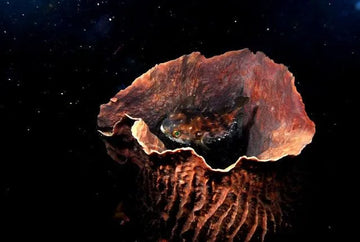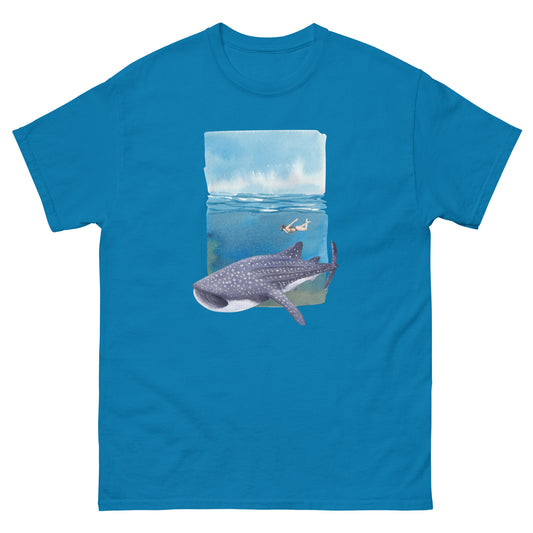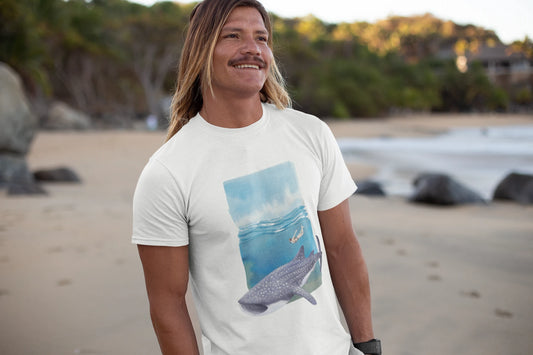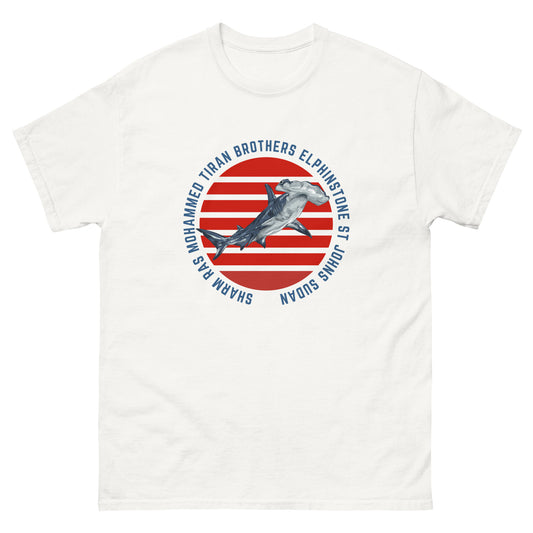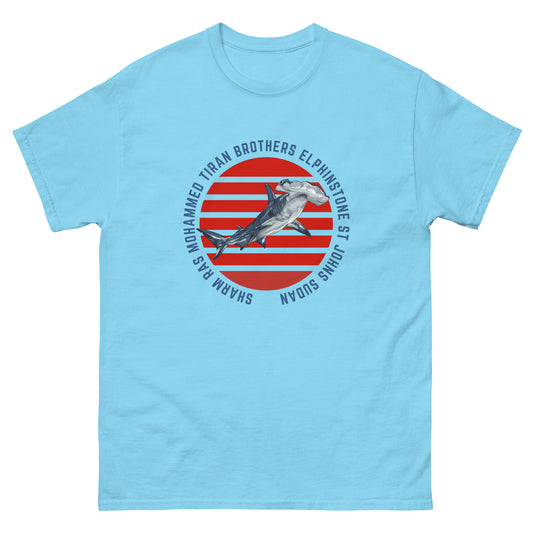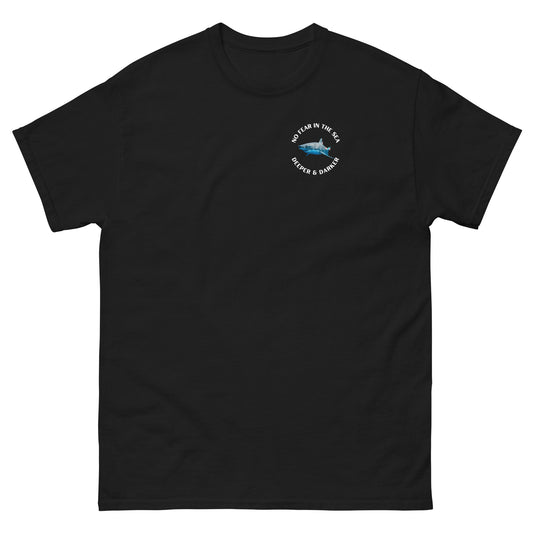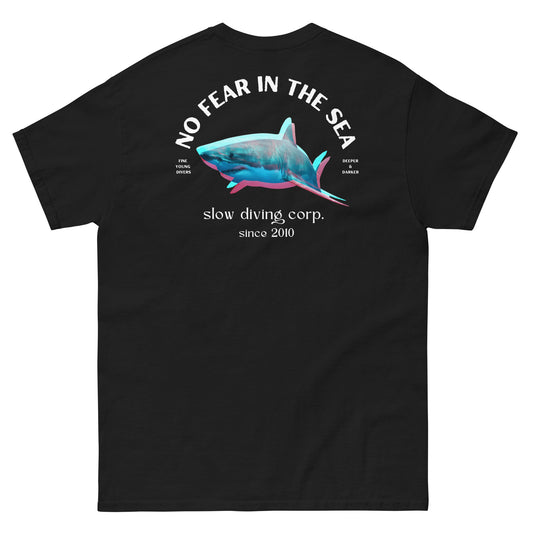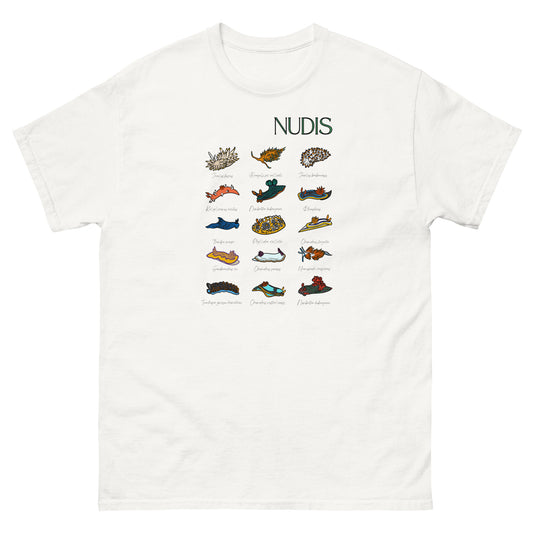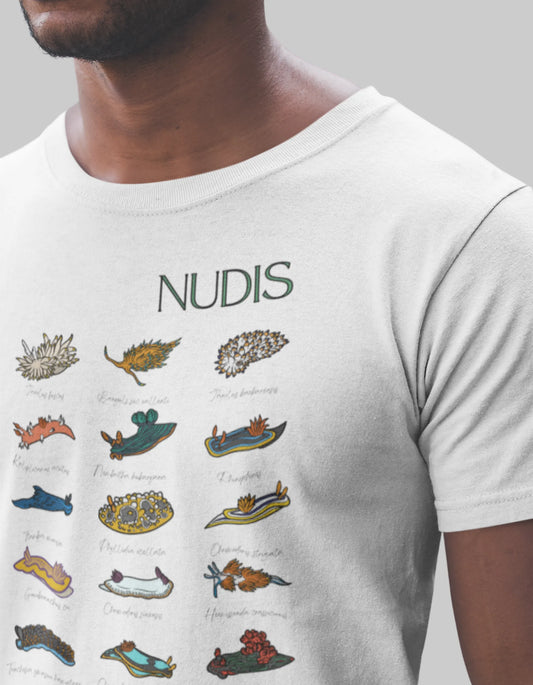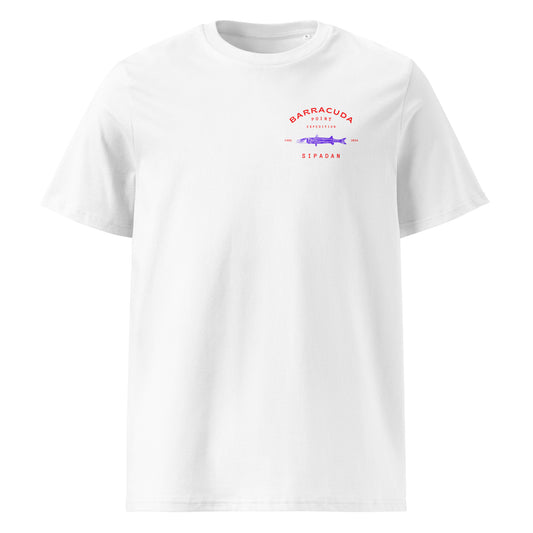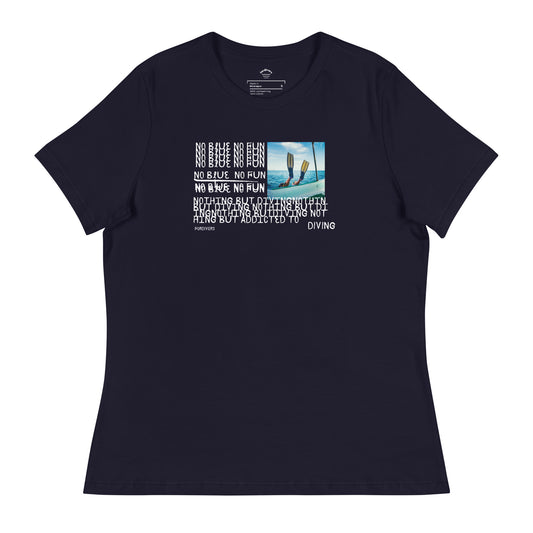Do you know what whales feed on? What areas of the planet do they inhabit? Which ones are more threatened? How do they communicate? Learn more about the 12 species of whales (broadly speaking, referring to all the great cetaceans included in the suborders Mysticeti and Odontoceti).
We study the blue whale, the fin whale, the southern right whale, Rudolph's rorqual, sperm whales, the humpback whale, the gray whale, the minke whale, the bowhead whale, Bryde's whale, the narwhal, and the beluga.
Blue whale

Blue whale feeding in Mexico
Blue whales are the largest mammals and, possibly, the largest animal that has ever lived on Earth, with specimens that can grow up to 33 meters long and weight 190 tons. The body of this marine mammal is bluish gray along the back and slightly lighter on the belly.
T-shirts for Whale Lovers
SEE MORE WHALE T-SHIRTSBlue whales feed almost exclusively on krill (shrimp-like crustaceans between 3 and 5 cm long) although their diet changes depending on the ocean in which they are located. An adult blue whale is able to eat 40 million krill in a single day! One of the most notable characteristics of blue whales is their ability to produce powerful low frequency sounds with which they communicate over long distances.
While difficult to capture because of their size, speed and strength, blue whales were hunted close to extinction in the twentieth century. In the 1960s, conservation efforts begun that have reduced this rapid population decline but they are still today in danger of extinction. It is estimated that there are more blue whales in the southern hemisphere, with around 2,300 blue whales now and its population growing at a 7% rate per annum.
The only predator that the blue whale has, besides man, is the orca. Research conducted in the Sea of Cortez showed that 25% of studied blue whales had scars from orca attacks. The average dive time of the blue whale is only 11 minutes and can reach speeds up to 27 knots (50 km/h) when in danger.
Fin whale

The fin whale is the second largest species of whale after the blue whale. Its body is long and slim, with gray skin tones that turn to white at the bottom. Fin whales can be found in all major oceans of the planet, from polar to tropical waters.
Fin whales reach about 20 meters long (having documented specimens of up to 27 meters) and an estimated adult weighs around 70 tons. They are very long-lived animals that can reach up to 100 years old.
To catch their food they can dip to 200 meters in search of krill but their diet also includes small fish, squids and crustaceans. This whale can swallow 10 kg of krill on each bite and can consume up to two tons per day.
Southern right whale
The southern right whale has a size of between 13 and 16 meters long and weighs 40 tons. These whales have a curved mouth with an upper jaw filled with about 260 "whiskers" that can be to 250 cm long. When whales feed they use these beards as filters to retain their basic food: krill.
Show Your Love for Whales
SEE MORE WHALE SWEATSHIRTSThe right whale lives in latitudes ranging from 20° to 60° in the North Pacific, North Atlantic, South Atlantic, South Indian and some areas of the South Pacific. During the nineteenth century the population was reduced by 90% because they are easy whales to hunt due to their slow movements and because they float when dead, unlike other whales. Today the oceans are home to about 8,000 right whales and only 400 of them live in the North Atlantic.
One of the most curious things of these whales are some calluses that arise in different parts of his head and that can be used to identify each individual as it is developed in the fetal stage and remains the same until its death. These prominences, about 5 centimeters long, are located along the lower lip on the eyes and on both sides of the jaw. This calluses are home to cling, or whale lice, make the calluses change color from white to yellow, orange or pink.
Sei whale

The Sei whale (named after the Norwegian for "cod", one of the foods of this whale) is always in the open sea and has a length of 12 to 16 meters and can reach a weight of 30 tons. His skin is dark in the back and white on the bottom. The Sei whale usually swim in groups of 3 to 5, but you can see them in larger groups in areas where there is plenty of food. They are as fast as the blue whales and prefer deep waters. They can be found in virtually all the world except in the Indian Ocean and at the poles.
Their food is varied and they feed on fish in large schools, plankton, crustaceans and squids, but also add cod to its diet.
During the first half of the twentieth century it was decimated and almost 200,000 specimens were hunted in a few decades. It was the main objective of whalers because of the dramatic reduction in the number of specimens of other commercial species. Today Sei whales are protected internationally although the Japanese government allows to hunt up to 100 Sei whales a year in the North Pacific for scientific research.
Sperm Whale

Sperm whales are the largest toothed animals that exist and the largest living predator, able to feed on species such as the giant squid. Sperm whales also have the biggest brain that ever existed, which can reach a weight of 9 kg, inside a huge head that occupies a third of his body. These whales reach 18 meters long and 48 tons in weight.
They are capable of diving to depths of 1,500 meters and stay underwater for up to 90 minutes. Sperm whales make clicking sounds that have a dual purpose: it serves as sonar to find food in areas in total darkness and they also use it to stun prey. Sperm whales live in groups, spending up to 10 years taking care of their offspring, always being stuck to their mother and away from the older specimens. They can reach the age of 70 years old.
Sperm whales are found almost everywhere in the world except in very cold waters up to 1,000 meters deep. This species has almost no natural predators because few animals dare to attack an adult, however orcas can attack groups and sometimes get to kill pups.
Although figures are not certain about the actual number of specimens, it is estimated that around 360,000 sperm whales live in our oceans, considered then a vulnerable species but not endangered as other whales.
Unlike other whales, and because of their enormous teeth, they can feed on species of considerable size as the colossal squid, octopus, rays and sharks. There are no documents confirming the epic battles of sperm whales and the giant squid but many of these amazing whales have been found with scars in their skin, made by large squids.
The famous whale in the novel Moby-Dick by Herman Melville is a sperm whale of great ferocity, reputation earned during the nineteenth century as these mammals occasionally defended themselves during the killings of some whalers, destroying their ships when they collided.
Humpback whale

Humpback whale "posing" for photographers. Image by Film Equals
This agile and acrobatic animal is one of the largest rorquals in the family. Its enormous size, 16 meters long and weighing 36 tons, does not prevent it from jumping several meters above the water and performing aerial spins. It is common to see it performing spectacular demonstrations in front of tourists looking for these sightings. The species has a distinctive body shape from other whales as it has long pectoral fins that move when it is in the air.
Humpback whales can be found in all the oceans and seas of the planet as they make very long migrations of about 25,000 kilometers each year. During these migrations they move from polar waters to tropical waters to reproduce and then return to colder waters in summer. Their staple food is krill and small schooling fish and they only feed during the summer in arctic regions and allow themselves to subsist the rest of the year thanks to their fat reserves.
Humpback whales have an incredible team hunting technique. When they encounter a large school of fish, they create a wall of bubbles around them, grouping millions of fish to make them rise to the surface. Then the leader of the herd shows the group the moment of the attack and they all go up to the surface to feed. This behavior demonstrates the intelligence of this animal, its ability to communicate and work as a team.
Another peculiar characteristic of humpback whales is that males produce a song that they maintain for ten to twenty minutes and repeat for hours at precise intervals. Although it is not clear what they want to communicate with these sounds, it is believed that they are necessary during the mating season.
The humpback whale population was driven to near extermination until 1950, when only 10% of the population that existed during the 18th century remained. Although the population is recovering at a good pace, man continues to be an enemy for these cetaceans. Fishing nets, hunting, accidents with ships or noise pollution seriously harm the 80,000 specimens that still swim in our oceans.
Grey whale

The gray whale is the star of migrations among whales, making journeys of up to 30,000 kilometers from Mexico to the Bering Sea, where it forages for food during the hottest times of the year.
At 15 meters long and weighing more than 20 tons, it has a skin of gray tones and white areas that allow, as in the case of the southern right whale, to perfectly identify each specimen. Parasites, and even barnacles, also attach themselves to this whale and accompany it on its long journeys.
With a relatively small head, this whale has a long mouth and 50-centimeter baleen that it also uses to filter krill and small crustaceans that it collects from muddy areas that it lifts with its jaw.
Gray whales are slow and parsimonious animals that have suffered a severe reduction of their population to the point of being considered practically extinct at the end of the 19th century due to their easy capture by whalers. In the middle of the last century it was considered a protected species, with only 20,000 specimens estimated to inhabit the planet. Indiscriminate hunting as well as human factors such as oil spills or plastics and glass found on the seabed make this species the most critically endangered.
Fin whale or minke whale

This whale has different denominations such as fin whale, minke whale, Antarctic minke or pygmy right whale. It is a small species of whale that only reaches 9 meters in length and 9 tons in weight and, although it inhabits all the oceans of the southern hemisphere, it is easier to see it in Antarctic waters.
Of dark gray color and whitish belly, they are fast swimmers that have suffered like no other whale species from indiscriminate hunting, mainly by Japanese whalers, the main cause of the near disappearance of many cetacean species. Today, the fin whale is not among the most endangered species and there are an estimated 145,000 living whales in the North Atlantic and 25,000 in the western North Pacific.
Bowhead whale

The bowhead whale has a robust body that can grow up to 18 meters and weigh up to 100 tons. Its habitat is located in arctic areas (for this reason it is also known as the Greenland whale) and it is there where it can be found since, unlike other whales, it does not make long migrations and always stays in areas surrounding the Arctic. It is directly related to the southern right whale and, like it, has filters in its mouth that help it feed on krill, although it also consumes small crustaceans.
They are easily identifiable due to their huge head, which occupies a third of their size, like sperm whales. They do not have a dorsal fin and their mouth is rounded in the shape of an arch. This arched shape, together with the impressive size of its head, helps it to break through the ice and make its way through Arctic waters. Another characteristic that facilitates their identification is a "collar" of white spots under the mouth.
It is a species of whale that always lives in groups, having found up to 14 members together. This is the longest-lived whale of all, since ivory points embedded in their skin have been discovered in living whales, which shows that there are specimens capable of living between 150 and 200 years.
The bowhead whale is also in danger of extinction due to its massive hunting during the 19th century. Since 1960 it has been among the protected species and although its growth is 3% per year, there are environmental factors that continue to endanger its continuity on Earth.
Bryde's Whale

The Bryde's whale is the least known and least studied species of fin whales, sometimes confused with Sei whales due to their similarity. It lives in tropical waters and prefers to get closer to the coasts instead of inhabiting the open sea. Like other fin whales, it has baleen that other species use to filter krill, but the Bryde's whale feeds exclusively on fish.
With a broad and small head, it has three longitudinal ridges on its head and is identifiable by a long, curved dorsal fin. Its skin colors range from dark black to bluish black, with a cream-colored belly and, like other whales, it carries parasites attached to its skin, giving it different shades throughout its body. Its small size, from 13 to 14.5 meters in length and between 16 and 18.5 tons in weight, makes it the prey of sharks and orcas, which leave marks and scars on many specimens that show that they have been victims of these attacks. Although there are no conclusive data, it is believed that only 25,000 specimens of this species remain settled in the North Pacific.
Narwhal
The narwhal is an odontocete cetacean with an extraordinary peculiarity: from its forehead comes a long and twisted tusk that can reach two meters and a weight of ten kilograms. Together with its mottled gray skin, it is absolutely unmistakable and was considered a mythological animal for centuries.
This cetacean species has adapted perfectly to life in the Arctic, occupying northern Canada, the Russian Arctic zone and the northern Atlantic. It prefers to live around ice shelves during the long Arctic winters and migrates to the bays around the pole in summer.
The size of the narwhal ranges from 4 to 4.5 meters and it reaches a weight of more than one ton. Its diet is based on fish and crustaceans that it catches from the seabed during the winter. Like many other cetaceans, they dive to depths of up to one kilometer to obtain their food through dives of up to 30 minutes.
Its population is estimated to be around 75,000 specimens, and its continuity on the planet is not in danger, although melting ice and pollution may begin to endanger its permanence. In addition to the Inuit people, who hunt narwhals for their meat, fat and for the sale of their tusks, they face threats such as Greenland sharks, polar bears and killer whales.
The narwhal puts its long tusk to different uses, from piercing ice sheets to breathe to echolocation, to find prey in the depths where light cannot reach, as a defense or even in mating rituals to demonstrate to females its dominance over other males.
During the Middle Ages the Vikings sold narwhal tusks claiming they were unicorn horns with powers such as curing poisoning or eliminating melancholy. These tusks had great value and were sometimes worth their weight in gold. With them they made cups that, according to the beliefs, could counteract any poison.
Beluga whale

The beluga whale is another species of odontocete cetacean that lives almost exclusively in Arctic regions and is related to narwhals.
It is easily recognizable for being white throughout its body and for not having a dorsal fin. Another of its most striking features is a frontal prominence that houses the organ called melon. This organ, common in cetaceans, is used for echolocation and the emission of sounds for communication with other specimens of its species. The melon of the beluga whale is the most developed of all cetaceans, capable of showing even where there are vents under ice shelves. It also has a highly developed sense of hearing, being one of the most vocal whales with the largest repertoire. Beluga whales emit eleven different sounds similar to whistles, cackles, trills and squawks and use body language by gnashing their teeth or splashing.
Male beluga whales usually reach 5.5 meters in length and weigh around 1,600 kg and, like narwhals, they are very social animals, forming groups of thousands of individuals in summer in coastal waters. Although they swim slowly, with a maximum of 22 km/h, they are great divers capable of diving up to 700 meters to reach their food: crustaceans, arctic cod, shrimp, salmon and even octopus.
The consumption of beluga whales greatly helped the subsistence of the natives of North America and Russia for centuries and was hunted for the sale of its meat and fat during the 19th century. In the 1970s it was declared a protected species and is not currently in danger of extinction. Its population is estimated at 150,000 specimens. Like narwhals, other animal species are its main threat, as they are hunted by polar bears, killer whales or Greenland sharks.

